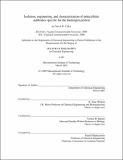Isolation, engineering, and characterization of intracellular antibodies specific for the huntingtin protein
Author(s)
Colby, David W. (David Wesley)
DownloadFull printable version (5.225Mb)
Other Contributors
Massachusetts Institute of Technology. Dept. of Chemical Engineering.
Advisor
K. Dane Wittrup and Vernon M. Ingram.
Terms of use
Metadata
Show full item recordAbstract
Huntington's Disease (HD) is an autosomal dominant neurodegenerative disorder caused by an expansion in the number of polyglutamine-encoding CAG repeats in the gene that encodes the huntingtin (htt) protein. A property of the mutant protein that is intimately involved in the development of the disease is the propensity of an N-terminal proteolytic htt fragment containing the glutamine-expanded region to misfold and adopt a conformation which is prone to aggregation. Intracellular antibodies (intrabodies) against htt have been shown to reduce htt aggregation by binding to the htt fragment and inactivating it or preventing its misfolding. Intrabodies may therefore be a useful gene therapy approach to treatment of the disease. However, high expression levels of previously reported intrabodies have been required to obtain even limited reductions in htt aggregation. We have used yeast surface display (YSD) of antibodies combined with fluorescence activated cell sorting (FACS) to isolate novel single-chain antibody (scFv) clones against huntingtin from a non-immune human antibody library; these scFv's did not inhibit htt aggregation. Engineering analysis, including the derivation of equations that describe the probability that cells will form htt aggregates as a function of time and concentration, were used to estimate the intracellular expression level and binding affinity required for robust aggregation inhibition. (cont.) The pool of antibodies isolated was used as the starting point for engineering an intrabody with appropriate properties for intracellular activity. We then applied YSD to affinity mature this scFv pool for binding to the first 17 aa of htt and analyze the location of the binding site of the intrabody mutant with the highest affinity. Interestingly, the paratope was mapped exclusively to the variable light chain domain of the scFv. A single domain antibody was constructed consisting solely of this variable light chain domain, and was found to retain full binding activity to huntingtin. Cytoplasmic expression levels of the single domain were at least five-fold higher than the scFv, enabling mild aggregation inhibition. However, antibodies expressed in the cytoplasm do not form intradomain disulfide bonds as they do when secreted from cells. By mutating the cysteine residues that form the disulfide bond in the single-domain antibody to hydrophobic amino acids, we found that antibody binding affinity was drastically reduced in the absence of the disulfide bond. Effectiveness of the single-domain intrabody was improved by increasing its affinity in the absence of a disulfide bond. The engineered intrabody, VL12.3, eliminated toxicity in a neuronal model of HD. We also found that VL12.3 inhibited aggregation and toxicity in a S. cerevisiae model of HD. VL12.3 is significantly more efficient than earlier anti-htt intrabodies, and is a potential candidate for gene therapy treatment for HD. (cont.) The approach demonstrated to improve intrabody potency through the use of highly expressed single-domain antibody fragments and disulfide bond-independent binding suggests a generally applicable approach to the development of effective intrabodies against other intracellular targets.
Description
Thesis (Ph. D.)--Massachusetts Institute of Technology, Dept. of Chemical Engineering, 2005. This electronic version was submitted by the student author. The certified thesis is available in the Institute Archives and Special Collections. Vita. Includes bibliographical references (leaves 128-134).
Date issued
2005Department
Massachusetts Institute of Technology. Department of Chemical EngineeringPublisher
Massachusetts Institute of Technology
Keywords
Chemical Engineering.